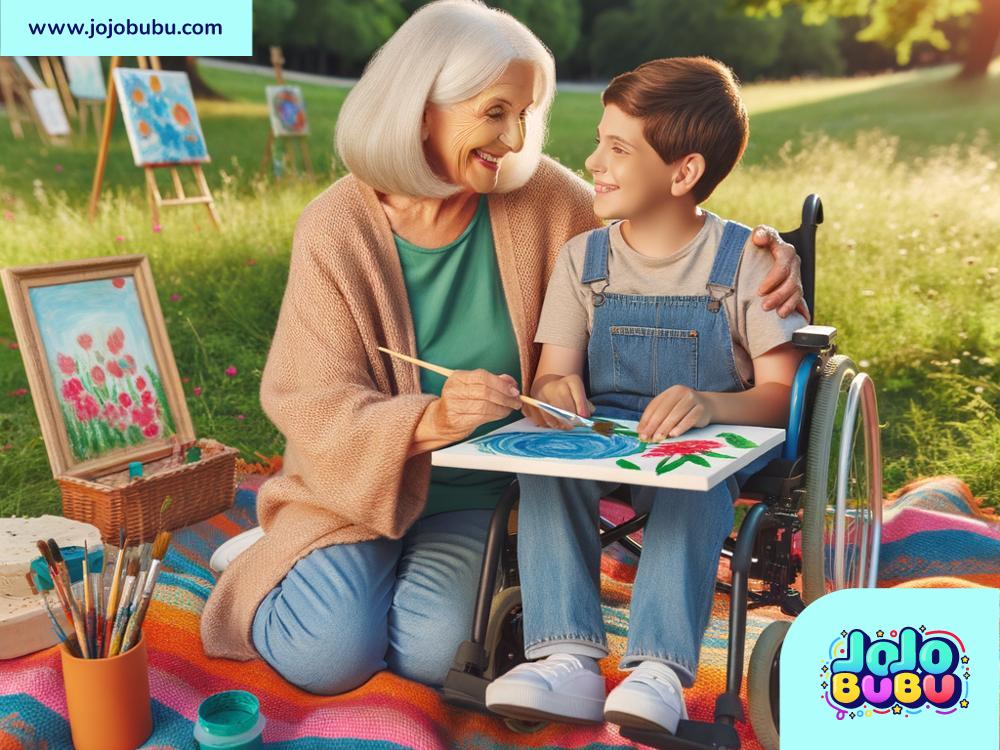Special Activities for Differently-Abled Grandchildren
Being a grandparent is one of life’s greatest joys. It’s about spending precious time, creating lasting memories, and nurturing the bond between you and your grandchildren. When your grandchild is differently-abled, your love remains the same, but you might need to adjust activities to better suit their unique needs and abilities. Every child has their own strengths and challenges, and by embracing these, you can help them thrive while having fun.
The right activities can not only bring laughter and joy but also encourage growth, learning, and confidence. Here's a list of special activities that can help make time with your differently-abled grandchild meaningful and engaging.
1. Art and Craft Projects: Let Creativity Bloom
Art is a universal language that allows children to express themselves without words. Whether it's painting, drawing, cutting paper shapes, or making clay models, there are endless ways to create. For grandchildren with mobility challenges, you can use tools like adaptive paintbrushes or easier-to-hold crayons. If your grandchild is visually impaired, try tactile art like creating textures using glue, sand, or leaves.
The key is to let them explore at their own pace without focusing on perfection. Praise their creative efforts and hang up their art to show how much you appreciate their hard work.
2. Music and Dance: Feel the Rhythm
Music has a magical way of lifting spirits and soothing the soul. Sing songs together or explore different instruments like drums, tambourines, or even a small keyboard. If your grandchild enjoys movement, you can dance with them to their favorite tunes. For children sensitive to sound or who process sensory inputs differently, stick to calming melodies at a comfortable volume.
Music therapy is known to help with emotional and physical development—so don't worry about the performance but focus on having fun. Clap, stomp, or sway to the beat and let the rhythm guide your joy.
3. Gardening Together: Nurturing Life
Gardening is a lovely way to teach children about life cycles while engaging their senses. Plant seeds, water flowers, or dig soil together. Differently-abled children, particularly those with physical or cognitive challenges, can benefit from hands-on interaction with nature.
For grandchildren who might not be able to move freely, you can set up a raised garden bed or use pots on a tabletop to make gardening accessible. Watching the plants grow over time can be both exciting and motivating. Gardening also offers moments of calm and focus, which can be particularly beneficial for children who have sensory sensitivities.
4. Storytelling and Reading: Exploring Imaginary Worlds
Books and stories are tools for adventure, learning, and imagination. Read stories aloud, act out characters, or create your own tales together. If your grandchild has visual impairments, try audiobooks or textured tactile storybooks that allow them to ‘feel’ the story through pictures and patterns.
Let them engage however they feel comfortable. If they want to ask lots of questions about the story, encourage their curiosity. For children with communication challenges, picture books can help them connect ideas with images while boosting their vocabulary.
5. Cooking and Baking: A Recipe for Fun
Cooking with your grandchild can be a sensory delight. Stirring batter, measuring ingredients, tasting flavors—it’s all part of the fun. Simplify tasks to suit their abilities, such as sprinkling toppings, folding dough, or arranging fruit slices.
For grandchildren with motor challenges, there are adaptive kitchen tools like grippers for holding bowls or automatic stirring devices. Cooking can also be an opportunity to teach them patience and sequencing skills while sharing a yummy reward at the end.
6. Outdoor Adventures: Exploring the World Around Them
Nature has endless lessons to teach, and spending time outdoors can do wonders for any child. Take your grandchild to the park, go on gentle hikes, explore wheelchair-friendly trails, or have a picnic in your backyard. For differently-abled children, the sensory experiences of hearing birds sing, feeling the breeze, and walking (or being carried) through grass can be relaxing and stimulating.
If mobility limitations are a concern, start with small, easy outings, and think about adaptive equipment, like special carriers or sensory-friendly playgrounds.
7. Games and Puzzles: Sharpening Skills While Having Fun
Games are a great way to stimulate brain development and hand-eye coordination. Choose activities that fit their abilities—for example, oversized puzzles with big pieces or board games with simplified rules. Many toys and puzzles today are designed with differently-abled children in mind, offering sensory-friendly elements and ease of use.
Interactive games like blowing bubbles, rolling a ball, or stacking blocks can be accessible and fun for children with varying mobility levels. The goal is to spend quality time while encouraging problem-solving and teamwork.
8. Quality Time and Connection: Simple Acts of Love
At the end of the day, the most important "activity" is spending time together. Whether you’re just sitting and talking, cuddling, or enjoying quiet moments, your presence and attention mean the world to your grandchild. Even simple activities like coloring, watching cartoons, or playing pretend can bring joy.
Remember to always approach each activity with patience and flexibility. Let your grandchild set the pace, and celebrate every small achievement along the way.
Final Thoughts
Every grandchild is unique, and spending time together is about finding joy in the little things. Differently-abled children may need extra support, but with love and creativity, you can discover countless ways to adapt activities to meet their needs. Whether it's through arts, music, nature, or games, the time you spend together will create unforgettable memories.
Cherish these moments and embrace their uniqueness. After all, it’s not about what they can do—it’s about how much love and laughter you can share.

